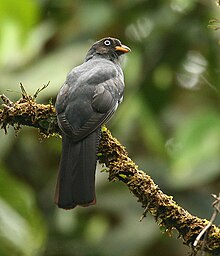| Lattice-tailed trogon | |
|---|---|

| |
| Female in Costa Rica | |

| |
| Male in Costa Rica | |
| Conservation status | |
 Least Concern (IUCN 3.1) | |
| Scientific classification | |
| Domain: | Eukaryota |
| Kingdom: | Animalia |
| Phylum: | Chordata |
| Class: | Aves |
| Order: | Trogoniformes |
| Family: | Trogonidae |
| Genus: | Trogon |
| Species: | T. clathratus |
| Binomial name | |
| Trogon clathratus Salvin, 1866 | |

| |
The lattice-tailed trogon (Trogon clathratus) is a species of bird in the family Trogonidae, the quetzals and trogons. It is found in Costa Rica and Panama.
Taxonomy and systematics
The lattice-tailed trogon is monotypic.
Description
The lattice-tailed trogon is about 30 cm (12 in) long and weighs about 130 g (4.6 oz). The male has a yellow bill, a whitish eye, and a blackish face, chin, and throat. The crown, nape, upperparts, and breast are iridescent green. The belly and vent are rosy red. The folded wing has fine black and white vermiculation that looks gray at a distance. The upperside of the tail is bluish green and underside slate gray with fine white bars. The female replaces the male's green with slaty gray, with an olive tint to the breast. The female's maxilla is dark.
Distribution and habitat
The lattice-tailed trogon is found along the Caribbean slope for the length of Costa Rica and into western Panama; it is also found locally on the Pacific slope in Panama. It inhabits the midstory and lower canopy of mature humid to wet foothill and lower mountain forest. It is usually found in the forest interior but also at the edges and into shady semi-open landscapes. In elevation it ranges between 90 and 1,360 m (300 and 4,500 ft). It descends to the lower elevations towards the end of the rainy season, but is almost never found in the level lowlands.
Behavior
Feeding
The lattice-tailed trogon's diet is mostly fruits and large insects but also occasionally includes small frogs and lizards.
Breeding
The lattice-tailed trogon's breeding season extends from February to May. It nests in a cavity excavated in a rotten tree or snag and sometimes an arboreal termitarium, usually between 5 and 8 m (16 and 26 ft) above ground.
|
Songs and calls Listen to lattice-tailed trogon on xeno-canto |
Vocalization
The lattice-tailed trogon's song is a "rapid series of c.15 loud, resonant clucking 'kwa' notes rising in pitch and volume to a crescendo in middle, then becoming faster, lower and softer".
Status
The IUCN has assessed the lattice-tailed trogon as being of Least Concern, though it has a restricted range and its unquantified population is believed to be decreasing. "Habitat destruction within its range now extensive, however, and careful evaluation of status needed."
References
- ^ BirdLife International (2016). "Lattice-tailed Trogon Trogon clathratus". IUCN Red List of Threatened Species. 2016. Retrieved 27 October 2021.
- ^ Gill, F.; Donsker, D.; Rasmussen, P. (July 2021). "IOC World Bird List (v 11.2)". Retrieved July 14, 2021.
- ^ Collar, N. (2020). Lattice-tailed Trogon (Trogon clathratus), version 1.0. In Birds of the World (J. del Hoyo, A. Elliott, J. Sargatal, D. A. Christie, and E. de Juana, Editors). Cornell Lab of Ornithology, Ithaca, NY, USA. https://doi.org/10.2173/bow.lattro1.01 retrieved October 27, 2021
